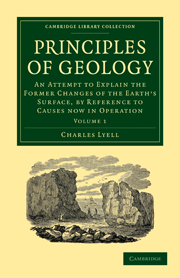 Principles of Geology
Principles of Geology As we have entered into a detailed historical account of the changes in the volcanic district round Naples, our limits will only permit us to allude in a cursory manner to some of the circumstances of principal interest in the history of other volcanic mountains. After Vesuvius, our most authentic records relate to Etna, which rises near the sea in solitary grandeur to the height of nearly eleven thousand feet, the mass being chiefly composed of volcanic matter ejected above the surface of the water. The base of the cone is almost circular∧ and eighty-seven English miles in circumference; but if we include the whole district over which its lavas extend, the circuit is probably twice that extent. The cone is divided by Nature into three distinct zones, called the fertile, the woody, and the desert regions. The first of these, comprising the delightful country around the skirts of the mountain, is well cultivated, thickly inhabited, and covered with olives, vines, corn, fruit-trees, and aromatic herbs. Higher up, the woody region encircles the mountain—an extensive forest, six or seven miles in width, affording pasturage for numerous flocks. The trees are of various species, the chestnut, oak, and pine, being most luxuriant; while, in some tracts, are groves of cork and beech. Above the forest is the desert region, a waste of black lava and scoriæ; where, on a kind of plain, rises the cone to the height of about eleven hundred feet, from which sulphureous vapours are continually evolved The most grand and original feature in the physiognomy of Etna are the multitude of minor cones which are distributed over its flanks, and which are most abundant in the woody region.
To save this book to your Kindle, first ensure no-reply@cambridge.org is added to your Approved Personal Document E-mail List under your Personal Document Settings on the Manage Your Content and Devices page of your Amazon account. Then enter the ‘name’ part of your Kindle email address below. Find out more about saving to your Kindle.
Note you can select to save to either the @free.kindle.com or @kindle.com variations. ‘@free.kindle.com’ emails are free but can only be saved to your device when it is connected to wi-fi. ‘@kindle.com’ emails can be delivered even when you are not connected to wi-fi, but note that service fees apply.
Find out more about the Kindle Personal Document Service.
To save content items to your account, please confirm that you agree to abide by our usage policies. If this is the first time you use this feature, you will be asked to authorise Cambridge Core to connect with your account. Find out more about saving content to Dropbox.
To save content items to your account, please confirm that you agree to abide by our usage policies. If this is the first time you use this feature, you will be asked to authorise Cambridge Core to connect with your account. Find out more about saving content to Google Drive.